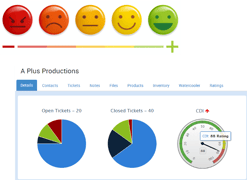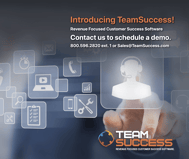“You’re not paying close enough attention to your customers.”
That’s how TeamSupport CEO Pete Khanna and ProfitSword VP of Sales and Marketing Paul Bennie began their speaking session at the recent TSIA Interact annual conference. This blog provides the highlights from their talk.
It was a provocative statement to introduce the session. What did they mean?
At TeamSupport we have a belief that B2B companies are neglecting their existing customers in favor of focusing on new business. Pete introduced the session by talking about why it’s so important to shift your focus to your existing customer base, what a positive impact it will make to your recurring revenue, and how today’s innovative technologies can help.
The Subscription Effect
30% of technology companies have come to market with, or moved exclusively to, a subscription licensing model.1 So, for to continue to flow, customers must continue to use your products. It is not sufficient to only satisfy customers, Support must deliver positive customer experiences that help sustain and grow existing relationships.
Historically, B2B customer support departments have not been thought of as revenue generating. But think about this: For many technology companies, 70% or more of revenue comes from existing customers.1 There must be a shift out of reactive mode and into far more effective proactive stances by gathering and using the data from every interaction to inform this approach.
How do you accomplish that?
There are three things you can do to achieve success for your customers…and for your bottom line.
 Ensure Product Adoption and Use
Ensure Product Adoption and Use
The best way to protect and expand your core business is to ensure your customers are succeeding with your product. If they do not fully use what they have already purchased, or if the perceived support users receive post-sale, beginning with onboarding, is less than positive, there is little likelihood they will purchase more or even renew current subscriptions.
Overall support demand grew by 10.6% in 2020. One of the largest drivers was higher user adoption, and two-thirds of support demand is related to the adoption and application of products.2 This creates an opportunity for support departments to get customers off on the right foot with early product use.
Where do you start?
Start by offering a comprehensive, personalized onboarding process that includes all users. Formal onboarding allows companies to proactively engage customers before they need assisted support. How you onboard your new customers sets the tone for your ongoing relationship with them. It also directly contributes to increasing customer lifetime value (LTV), reducing churn, and turning new users into raving fans.
Not convinced?
Formal onboarding is one of the most effective efforts to build customer skills, yet it is used by fewer than a third of companies. If you’re one of the companies that has yet to formalize your onboarding, consider this:
- 63% of customers in a recent study say that onboarding is an important consideration in whether they make the buying decision in the first place.3
- 86% of people say they’d be more likely to stay loyal to a business that invests in onboarding content that welcomes and educates them after they’ve bought.4
Remember, the quicker all users in your B2B customers’ support organization adopt your product and use it to its full benefit, the more likely they will recognize it as mission critical, increasing the likelihood of renewing exponentially.
What’s next?
 Mitigate Risks and Identify Opportunities
Mitigate Risks and Identify Opportunities
We’re all very focused on metrics related to the Marketing pipeline (number of MQLs, return on our paid search investment, cost-per-lead, etc.). And the Sales pipeline (number of opportunities, Closed Won per month, time to close, etc.)
But what about the Customer pipeline? We should be looking at just as many metrics related to our existing customers and just as diligently. (Remember, 70% or more of revenue comes from existing customers.)
 It’s time to go beyond the mad red face and green happy face to really determine the health of your customers. A tool like TeamSupport’s proprietary CDI™ (Customer Distress Index) provides a 0-100 score indicating how happy a customer may be with your business. This score can be customized by providing weights to specific values. It’s one way of getting ahead of the risk of a customer churning or capitalize on an upsell or cross-sell opportunity.
It’s time to go beyond the mad red face and green happy face to really determine the health of your customers. A tool like TeamSupport’s proprietary CDI™ (Customer Distress Index) provides a 0-100 score indicating how happy a customer may be with your business. This score can be customized by providing weights to specific values. It’s one way of getting ahead of the risk of a customer churning or capitalize on an upsell or cross-sell opportunity.
While most companies have formalized methods for capturing customer feedback, only 57% of companies have formal procedures to act on reported dissatisfaction.5
Get into a cadence of how you are looking at your data. This requires a system to track the impact of trends in real time.
What’s the end game?
 Reduce Churn and Prove Value
Reduce Churn and Prove Value
Reducing churn is no longer about stepping in and trying to “save” a customer once they have already made the decision to leave. You need to implement ongoing efforts to not only be able to prove your value but do so in a way that makes the customer feel like they will lose something very important to their business if they churn. In other words, you want them to think of you as mission-critical to their business.
Churn is the new revenue.
We have coined this phrase to reflect the importance of mitigating the risk of churn.
Reducing churn is no longer about stepping in and trying to “save” a customer once they have already made the decision to leave. Think about it. 25–95%. That’s the possible revenue increase when retention increases by 5%.
It’s not always about researching negative trends. Companies should also conduct research to determine the strong points of their customer experiences that lead to retention. Utilize advanced tools that Aggregate multiple data sources into a Customer Health Index that will provide a 360° view of customer status, satisfaction, and product usage.
How does it all come together?
“While virtually all customer success management initiatives start out as “churnfighters,” you can’t stop there. The challenge is to gather and use the data from every interaction to move your team out of reactive mode and into far more effective proactive stances.”6 It’s then that you start realizing the true value of ensuring success for your customers and driving recurring revenue.
As one industry CEO and author tells us, “The success of your business is inherently intertwined with the success of your customer.”
1-2,5Sweeney, Tom, Customer Support Transformation: The Guide to Essential Practices and Metrics, Dec 2020, Service Excellence Group, LLC. Download the report.
3-4Customer Onboarding Statistics 2020, Wyzowl.com. Retrieved April 1, 2020 https://www.wyzowl.com/customer-onboarding-statistics/
6The Definition of Customer Success, Customer Success Association, retrieved Nov 16, 2020, https://www.customersuccessassociation.com/library/the-definition-of-customer-success/

|
With increasing revenue as its primary focus, TeamSuccess boldly repositions the role of B2B customer success software in the industry. TeamSuccess allows customer success teams to easily monitor, automate, and streamline the customer lifecycle, creating more upsell opportunities, reducing the risk of churn, and ensuring that as customer relationships grow, so do contributions to the bottom line. Learn more at TeamSuccess.com. |
Looking For Startup Consultants ?
Call Pursho @ 0731-6725516
Telegram Group One Must Follow :
For Startups: https://t.me/daily_business_reads







